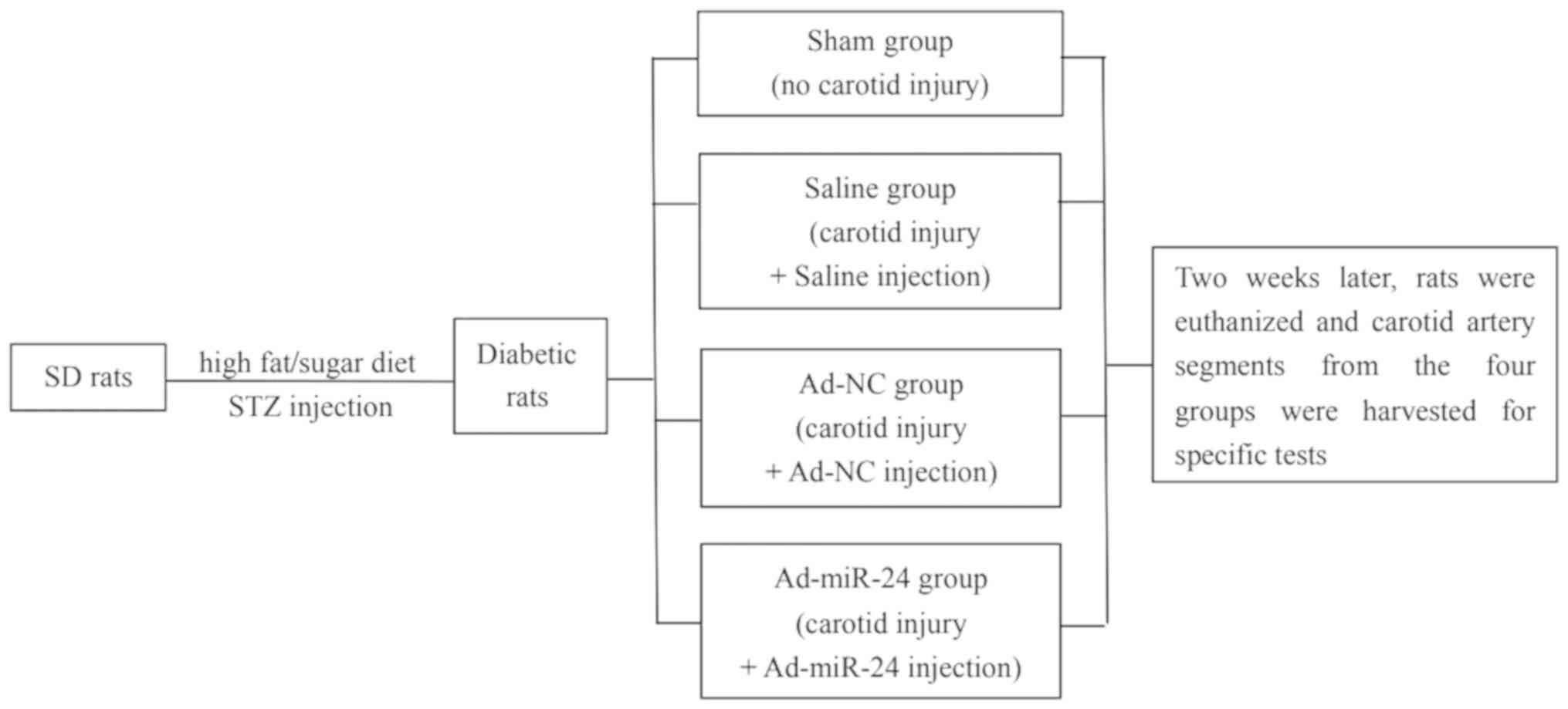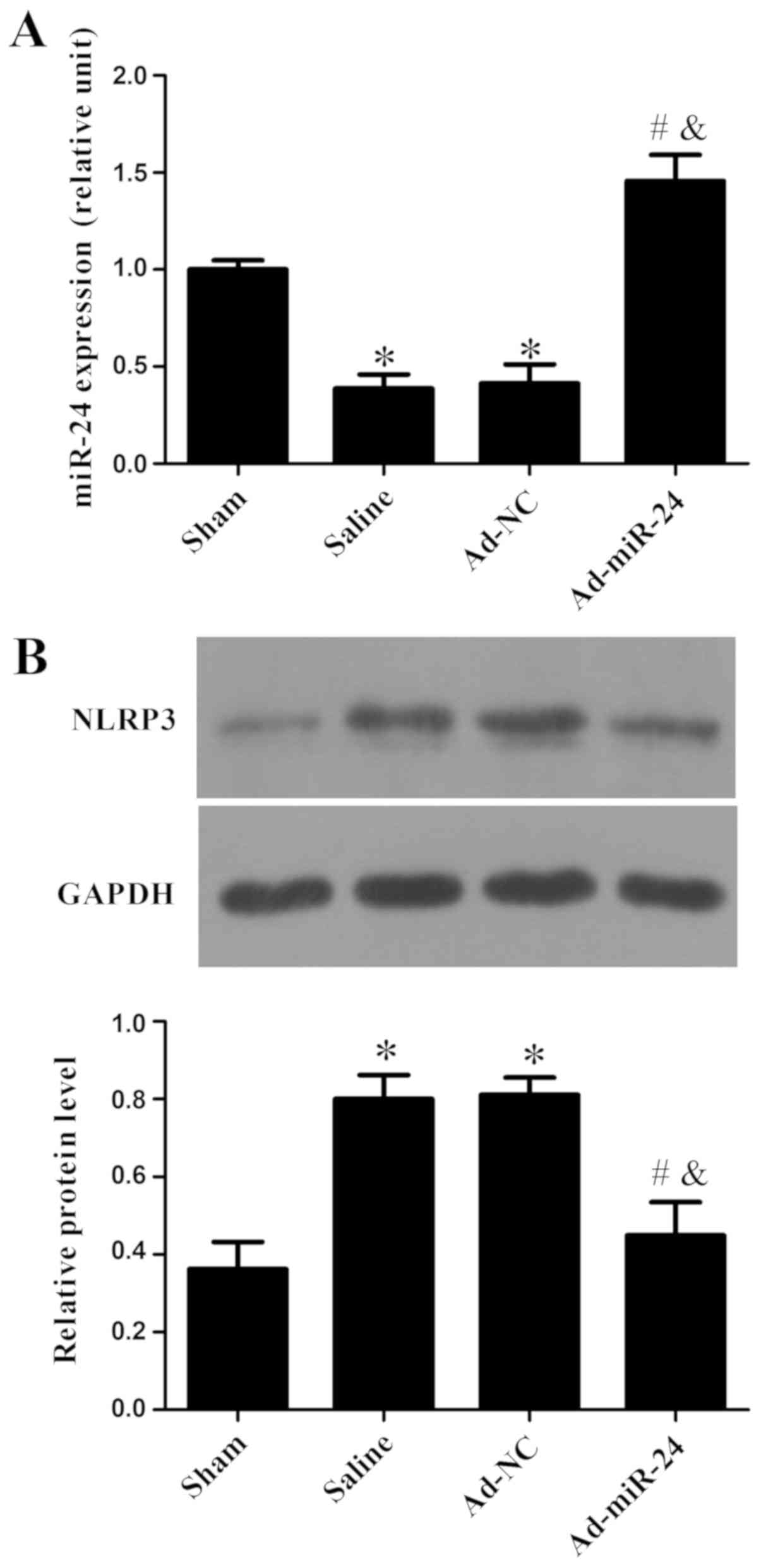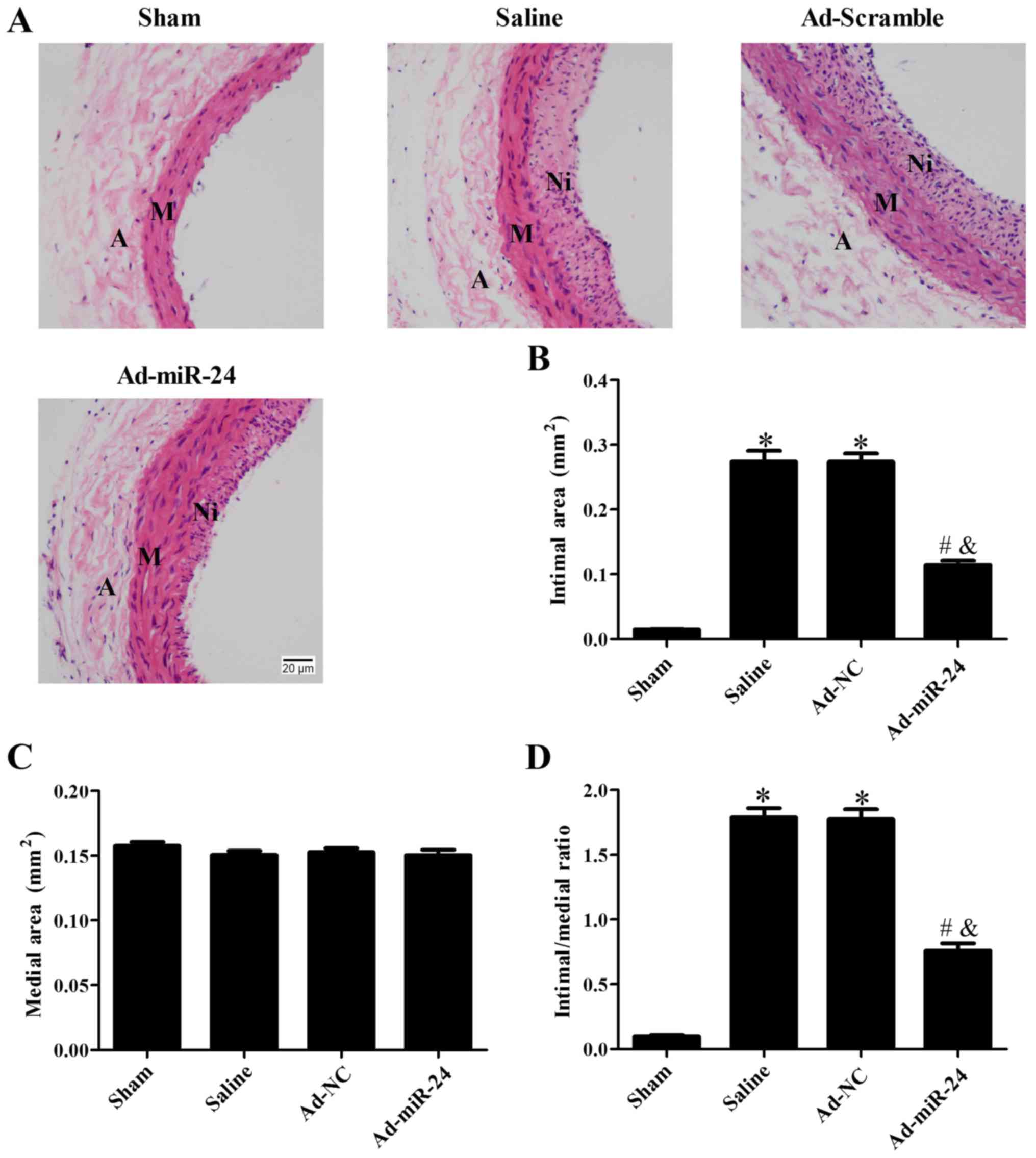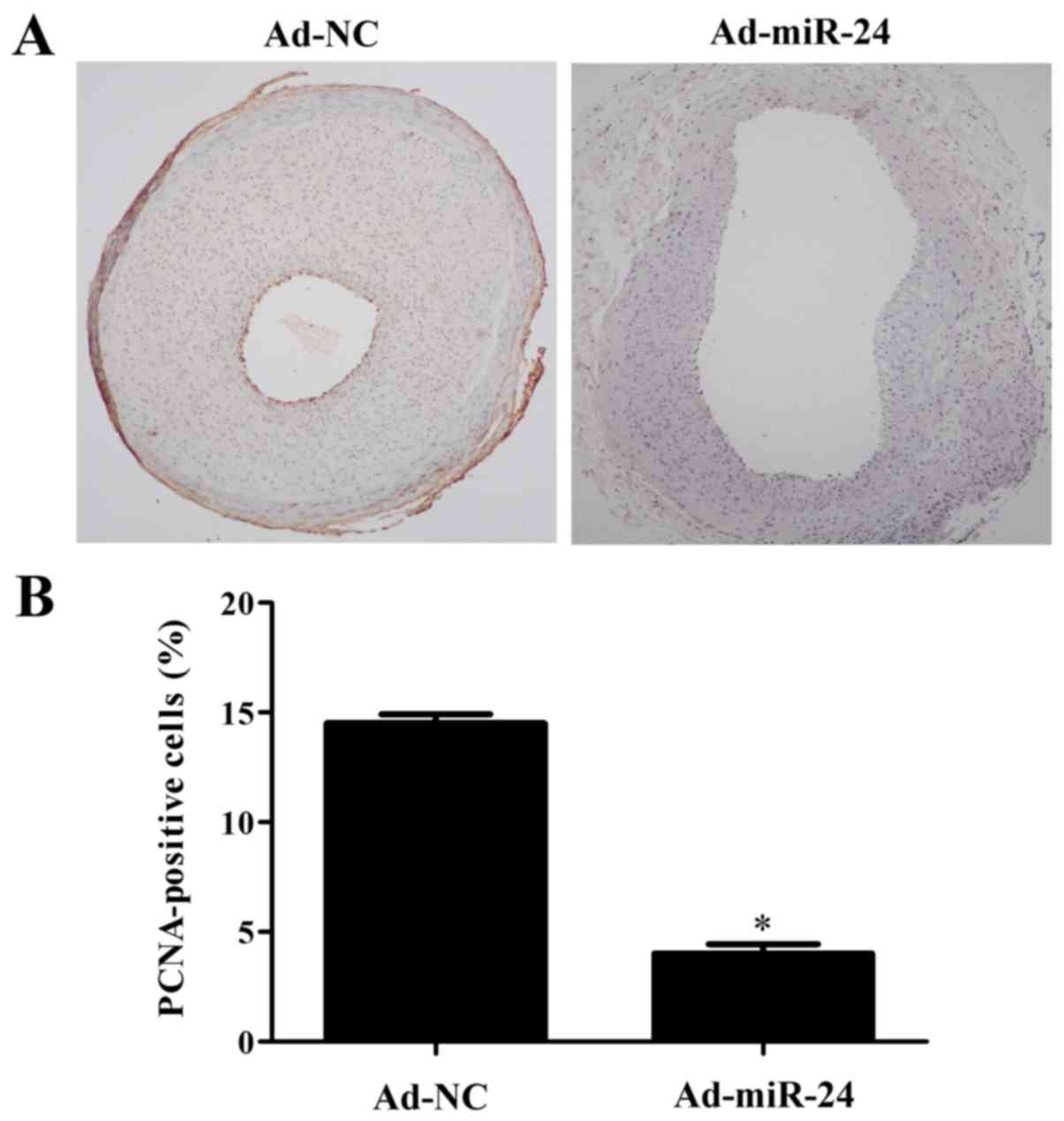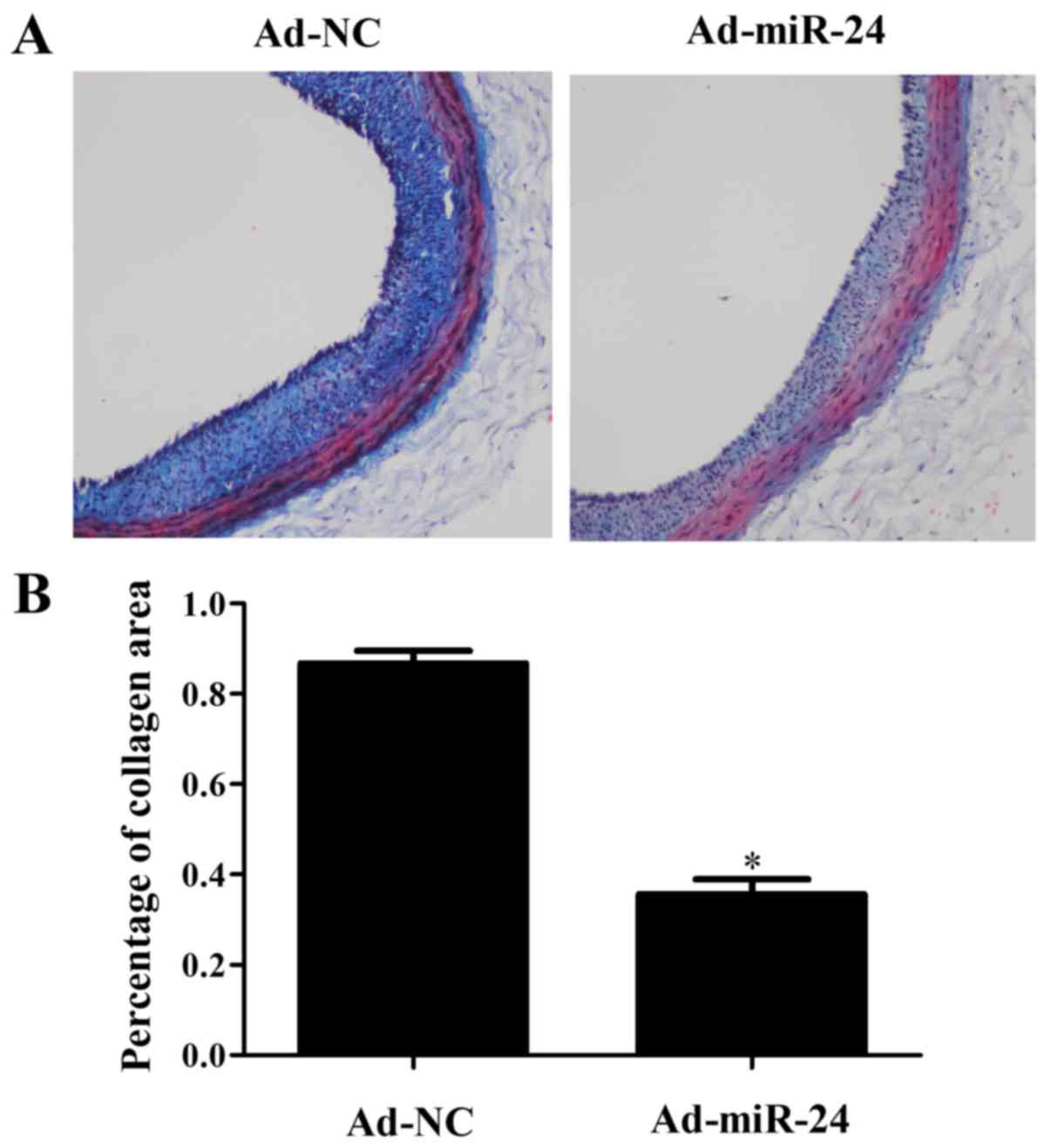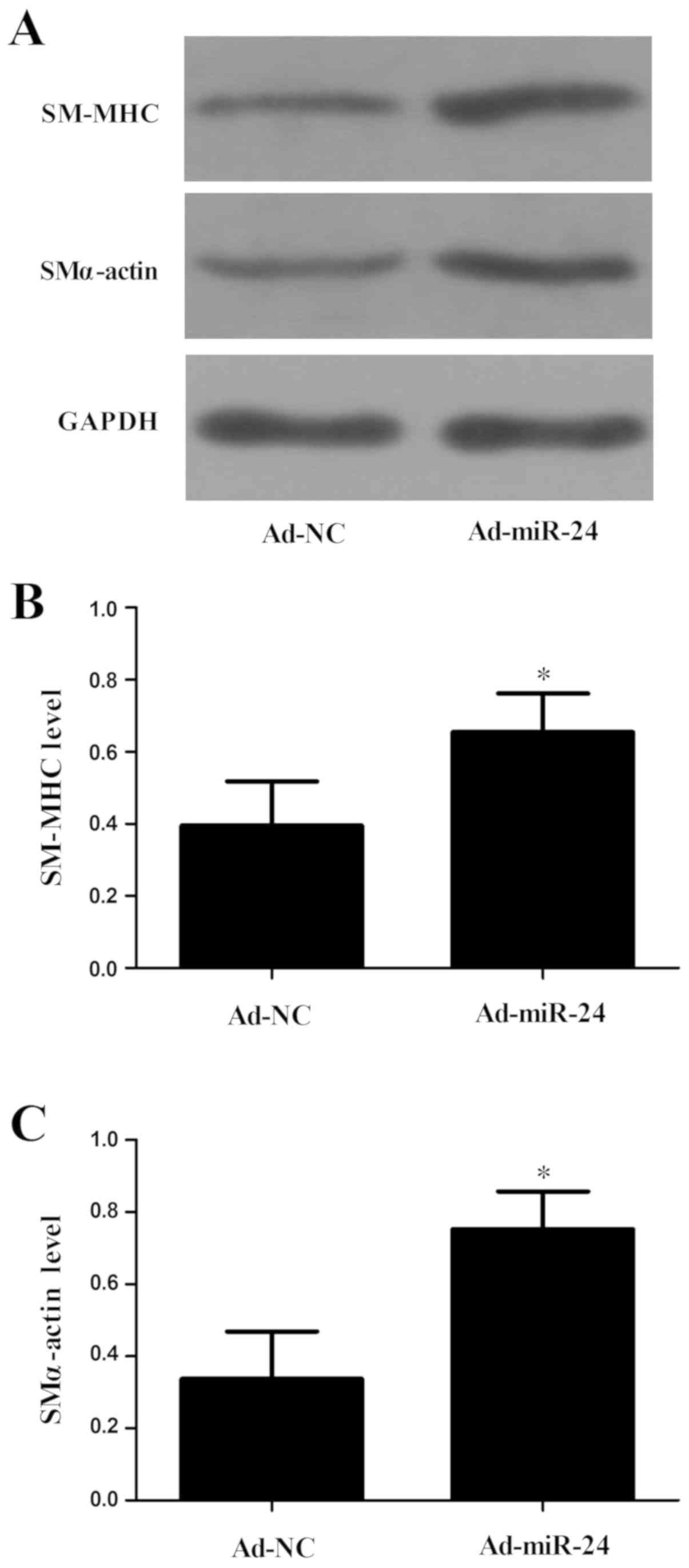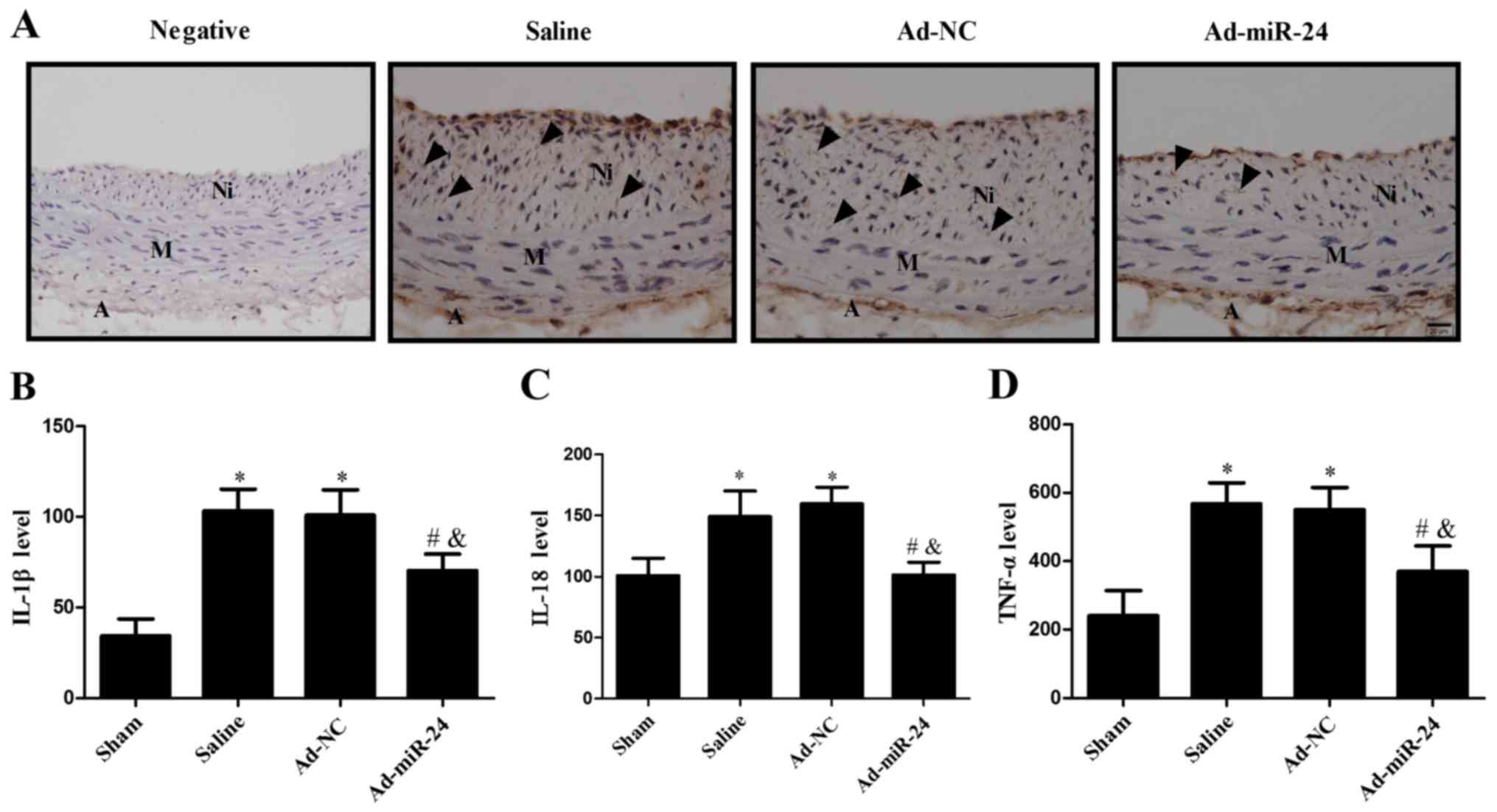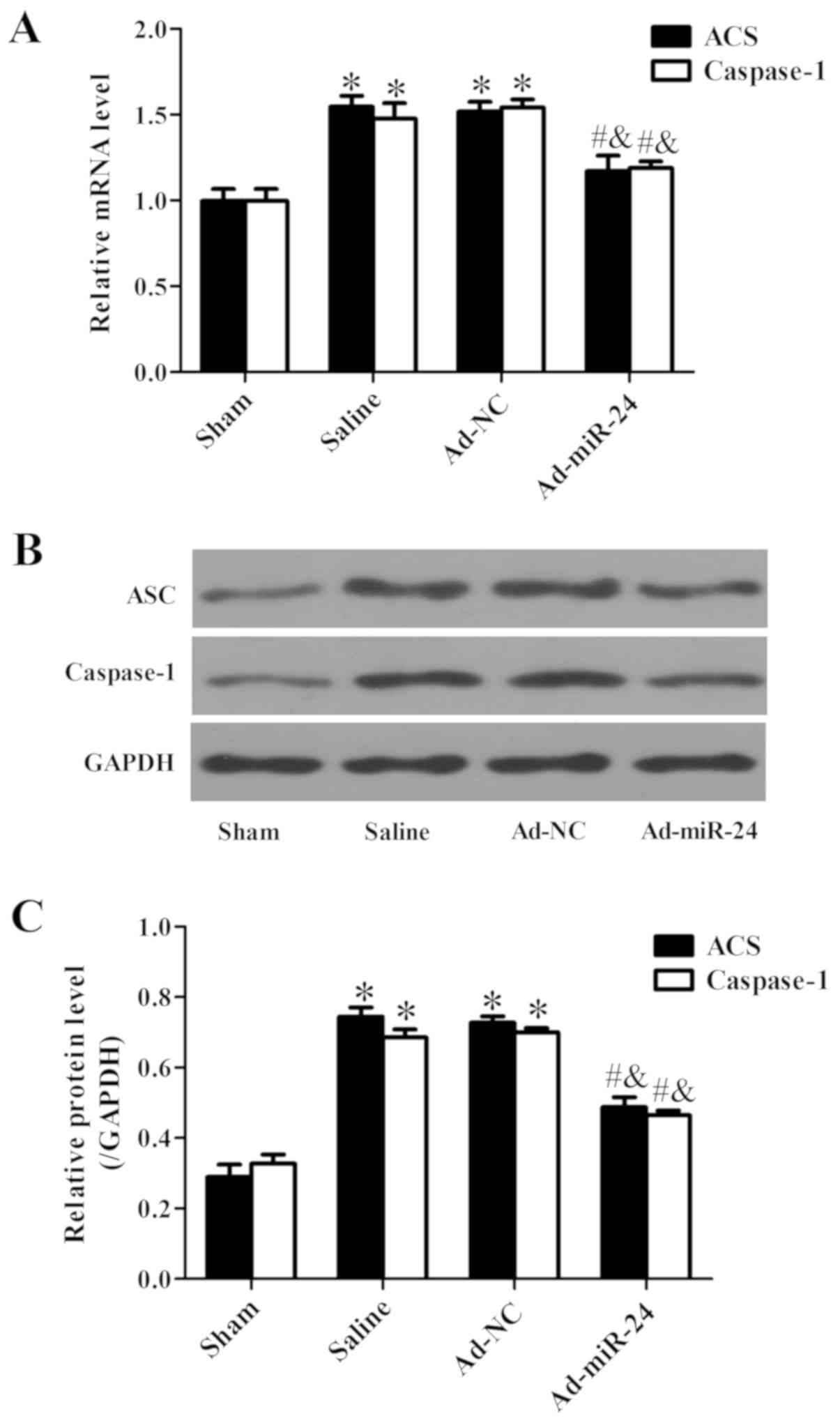MicroRNA‑24 attenuates diabetic vascular remodeling by suppressing the NLRP3/caspase‑1/IL‑1β signaling pathway
Corrigendum in: /10.3892/ijmm.2022.5079
- Authors:
- Published online on: March 9, 2020 https://doi.org/10.3892/ijmm.2020.4533
- Pages: 1534-1542
-
Copyright: © Fan et al. This is an open access article distributed under the terms of Creative Commons Attribution License.
Abstract
Introduction
Diabetes mellitus is a major risk factor of cardiovascular diseases, and diabetic patients develop more serious neointimal hyperplasia following coronary arterial interventions compared with non-diabetic patients (1,2). Vascular remodeling is the most important pathological basis of diabetic vascular complications, which is the major cause of mortality among patients with diabetes (3). Neointimal hyperplasia plays a crucial role in the process of diabetic vascular remodeling (4). It is commonly accepted that the contractile-synthetic phenotype transformation of vascular smooth muscle cells (VSMCs) is responsible for neointimal formation (5). A large number of experimental and clinical studies have been undertaken to investigate how to attenuate vascular remodeling by improving the function of VSMCs (6–8). However, no breakthrough progress has been made, and there are currently no promising strategies for alleviating diabetic vascular remodeling.
MicroRNAs (miRNAs/miRs) control diverse cellular functions by negatively modulating the expression of genes. A large number of studies have confirmed that dysregulated miRNAs are involved in the development of neointimal hyperplasia (9–12). Evidence has demonstrated that the expression of miR-24 differs significantly between patients with atherosclerosis and age-matched controls, whereas overexpression of miR-24 can suppress the development of atherosclerosis (13). Moreover, previously published data by the authors of the current study also indicated that miR-24 may regulate diabetic vascular remodeling by affecting the function of VSMCs (14–17). However, the potential molecular mechanisms have not yet been fully elucidated.
The NOD-like receptor family pyrin domain-containing 3 (NLRP3) inflammasome is a macromolecular complex that consists of NLRP3, an adaptor protein apoptosis-associated speck-like protein (ASC) and caspase-1. The NLRP3 inflammasome is activated to produce inflammatory factors, including interleukin (IL)-1β, IL-18 and tumor necrosis factor (TNF)-α (18). Inflammatory response is closely implicated in vascular proliferative diseases (19,20). It has been confirmed that the NLRP3-related inflammatory signaling pathway is involved in the proliferation and phenotype transformation of VSMCs (21,22). Moreover, NLRP3 is one of the miR-24 target genes predicted by bioinformatics and confirmed by previous experiments (23). However, whether miR-24 can attenuate diabetic vascular remodeling through targeting the NLRP3 signaling pathway remains largely unknown.
In the present study, a carotid artery balloon injury diabetic rat model was established in order to investigate whether the downregulation of NLRP3 by overexpression of miR-24 can attenuate diabetic vascular remodeling by reducing proliferation, phenotype transformation and inflammation in VSMCs. The aim of the study was to provide novel insights into the benefits and potential mechanisms of action of miR-24 against diabetic vascular remodeling.
Materials and methods
Ethics statement
All experimental procedures and animal care were approved by the Institutional Animal Care and Use Committee of China Three Gorges University, and conformed to the Guide for the Care and Use of Laboratory Animals by the National Institutes of Health (24).
Preparation of adenoviral vectors
The custom AdMax system (Microbix Biosystems Inc.) was used to generate adenoviral vectors according to the manufacturer’s protocols, which encoded miR-24 and GFP. Subsequently, the adenoviral vectors (500 μl) were transfected into 293 cells (cat. no. CRL-1573; American Type Culture Collection) using Lipofectamine™ 2000 (Invitrogen; Thermo Fisher Scientific, Inc.) to amplifythe generated adenoviral vectors until the viral titer reached 1×109 PFU/ml.
Establishment and evaluation of a rat model of diabetes
A total of 60 adult male Sprague Dawley rats (aged ~8 weeks; weight, ~270 g) housed at 23±2°C with 12-h light/dark cycles were on a high-fat and high-sugar diet (20% lard stearin, 10% sucrose, and 0.1% bile salt were added to the normal diet) and had free access to water for 4 weeks. Then, the rats were administered streptozotocin (~35 mg/kg) by intraperitoneal injection and had free access to food and water for 1 week. The blood sugar level in the tail vein was measured, and once that exceeded 15.0 mmol/l the diabetic rat model was considered to be successfully established (10).
Establishment of the carotid balloon injury diabetic rat model and viral infection
A total of 48 well-established diabetic rat models (weighing ~400 g) were assigned into the sham, saline, injury and GFP viral infection (Ad-NC), and injury and miR-24 viral infection (Ad-miR-24) groups (Fig. 1). The procedure for establishing a diabetic rat model of carotid balloon injury was as follows: 3% sodium pentobarbital (30 mg/kg) was used to anesthetize the rats, followed by exposing the left external carotid artery. Subsequently, a balloon catheter (diameter, 1.25 mm) was inserted into the left common carotid artery through the exposed external carotid artery, and the balloon was inflated and passed three times with rotation. In the sham group, left external carotid artery was exposed but a balloon was not inserted. For viral infection, equal volume (50 μl) of Ad-miR-24, Ad-NC and saline were incubated with the common carotid arteries. After ~30 min, the blood flow in the carotid artery was restored. Two weeks after viral infection, rats were re-anesthetized with 3% sodium pentobarbital (30 mg/kg) and the left common carotid artery and jugular vein were exposed. The left common carotid artery segments were harvested for subsequent examination. At this time, the rats were still under anesthesia. Finally, 10% potassium chloride (75 mg/kg) was injected via the jugular vein for euthanasia.
Histomorphological and immunohistochemical analysis
Paraformaldehyde (4.0%) was used to fix the harvested arteries for 48 h at room temperature and the specimens were then embedded in paraffin and cut into 4-μm-thick sections. Next, the tissue sections were heated at 60°C for 1 h then dewaxed and rehydrated by immersion in dimethylbenzene and ethanol series. Hematoxylin and eosin (H&E) staining was subsequently performed at room temperature (hematoxylin staining, 5 min; eosin staining, 2 min). A light microscope (magnification, ×200) was used for the analysis of neointima formation. Immunohistochemical staining of PCNA, CD45 and CD31 were performed to analyze the proliferative activity of VSMCs, infiltration of neutrophils and reendothelialization, respectively (16,25). Briefly, for immunohistochemical staining, the sections was de-waxed, and the antigen retrieval was performed by autoclaving at 121°C for 6 min. The sections were incubated with 1% goat serum (cat. no. 31873; Thermo Fisher Scientific, Inc.) for 30 min at room temperature. After blocking for nonspecific staining, the sections were incubated with anti-proliferating cell nuclear antigen (PCNA; dilution, 1:100; cat. no. ab18197; Abcam), anti-CD45 (dilution, 1:100; cat. no. ab10558; Abcam) or anti-CD31 (dilution 1:50; cat. no. ab24590; Abcam) antibodies overnight at 4°C. The sections were then incubated with a horseradish peroxidase-conjugated secondary antibody (dilution 1:3,000; cat. no. sc-2005; Santa Cruz Biotechnology, Inc.) for another 1 h at room temperature. Finally, 3,3′-diaminobenzidine and hematoxylin were separately added to the sections for 1 min at room temperature. A light microscope was also used for immunohistochemical analysis (magnification: PCNA, ×100; CD45, ×400; CD31, ×400). Masson’s trichrome staining was also performed to evaluate collagen deposition in the vessels, as previously described (26). Image-Pro Plus 5.0 software (Media Cybernetics, Inc.) was used to calculate the percentage of PCNA-positive cells and the areas of collagen, intima and media in the neointima.
Reverse transcription-quantitative PCR (RT-qPCR) analysis
The gene expression of miR-24, apoptosis-associated speck-like protein (ASC) and caspase-1 was assessed. Total RNA was extracted from the harvested artery specimens with TRIzol® reagent (Invitrogen; Thermo Fisher Scientific, Inc.). Obtained RNA (~4.0 μg) was then reverse-transcribed into cDNA using SuperScript IV Reverse Transcriptase (Thermo Fisher Scientific, Inc.) at 37°C for 60 min. RT-qPCR was performed using the ABI Prism 7500 system (Applied Biosystems; Thermo Fisher Scientific, Inc.) with luminaris color hiGreen qPCR master mix (Fermentas; Thermo Fisher Scientific, Inc.). The following thermocycling conditions were used for the qPCR: 50°C for 2 min and 95°C for 10 min; 40 cycles of 95°C for 30 sec and 60°C for 30 sec. Data were analyzed using the 2−ΔΔCq method (27). The following primers were used: miR-24 forward, 5′-TGCGCTGGCTCAGTTCAGCAGG-3′ and reverse, 5′-CCAGTGCAGGGTCCGAGGTATT-3′; U6 forward, 5′-CGCTTCGGCAGCACATATAC-3′ and reverse, 5′-AAATATGGAACGCTTCACGA-3′; caspase-1 forward, 5′-ACTCGTACACGTCTTGCCCTC-3′ and reverse, 5′-CTGGGCAGGCAGCAAATTC-3′; ASC forward, 5′-TGGAGTCGTATGGCTTGGAG-3′ and reverse, 5′-TGTCCTTCAGTCAGCACACT-3′; and GAPDH forward, 5′-TGGCCTTCCGTGTTCCTAC-3′ and reverse, 5′-GAGTTGCTGTTGAAGTCGCA-3′.
Western blotting
The protein expression levels of NLRP3, ASC, caspase-1 and GAPDH in the harvested artery specimens were also determined. Briefly, the proteins were extracted from the specimens using the protein extraction kit (cat. no. P0028; Beyotime Institute of Biotechnology) and the concentration was measured by bicinchoninic acid protein assay kit. The obtained proteins (40 μg) were separated by electrophoresis with NuPAGE™ Novex 4–12% Bis-Tris Protein Gel (Invitrogen; Thermo Fisher Scientific, Inc.) and transferred onto a polyvinylidene fluoride membrane. The membrane was blocked with 5% non-fat dry milk in PBS with 0.05% Tween-20 for 2 h at room temperature. Subsequently, the blocked membranes were incubated with primary antibodies against NLRP3 (cat. no. 13158), ASC (cat. no. 67824) and caspase-1 (cat. no. 3866) overnight at 4°C (dilution, 1:1,000; Cell Signaling Technology, Inc.). Finally, the membranes were incubated with horseradish peroxidase-conjugated rabbit anti-rat IgG secondary antibodies (dilution, 1:2,000; cat. no. GB-10041; Pierce; Thermo Fisher Scientific, Inc.) for another 2 h at room temperature. An enhanced chemiluminescence detection kit (Thermo Fisher Scientific, Inc.) was used for visualization and GAPDH served as a loading control. An Odyssey® Infrared Imaging system (model 9120; LI-COR Biosciences) was used to capture images of the membranes and Quantity One 1-D software (version 4.6.9; Bio-Rad Laboratories, Inc.) was used to quantify the protein bands.
ELISA
The ELISA method was used to determine the levels of TNF-α (cat. no. SRTA00; R&D Systems, Inc.), IL-1β (cat. no. SRLB00; R&D Systems, Inc.) and IL-18 (cat. no. CSB-E04610r; Cusabio Technology LLC) in the harvested artery specimens. Briefly, the harvested artery specimens were homogenized at 4°C, centrifuged at 500 × g and 4°C for 20 min, and then the supernatant was taken for ELISA detection following the manufacturer’s instructions.
Statistical analysis
All statistical analyses were performed with SPSS software (version 21.0; IBM Corp.). All values are presented as the mean ± standard deviation. Statistical comparisons between mean values of groups were assessed using one-way analysis of variance followed by Tukey’s post hoc test. P<0.05 was considered to indicate a statistically significant difference.
Results
Relative expression of miR-24 and NLRP3 in diabetic rats with balloon-injured arteries
As shown in Fig. 2A, miR-24 was markedly reduced in the carotid arteries of diabetic rats after injury compared with the sham group (P<0.05), and adenovirus-mediated miR-24 viral infection significantly increased miR-24 expression compared with the Ad-NC group (P<0.05). Western blotting was used to detect the expression of NLRP3. As shown in Fig. 2B, compared with the sham group, protein expression level of NLRP3 increased markedly in saline and Ad-NC groups. However, miR-24 viral infection significantly reduced NLRP3 protein levels compared with the saline or Ad-NC groups (P<0.05).
Overexpression of miR-24 inhibits neointimal hyperplasia
The intimal hyperplasia was assessed by H&E staining (Fig. 3). As shown in Fig. 3A and B, adenovirus-mediated miR-24 viral infection significantly reduced the neointimal area compared with saline and Ad-NC groups (P<0.05) and the changes in the ratio of intima/media were consistent with this observation (P<0.05; Fig. 3D). There were no marked changes in the total area of the medial layer between the four groups included in the current study (P>0.05; Fig. 3C).
Overexpression of miR-24 suppresses VSMC proliferation and phenotype transformation, and decreases collagen deposition
As shown in Fig. 4A and B, PCNA expression was markedly increased in the injured arteries, but miR-24 overexpression was able to reduce the level of PCNA by 68% (P<0.05). In addition, the collagen deposition in the injured artery was assessed by Masson’s trichrome staining. As shown in Fig. 5, compared with the Ad-NC group, the level of collagen in injured arteries was lower in the Ad-miR-24 group (P<0.05). Compared with the Ad-NC group, expression levels of contractile markers, including smooth muscle (SM) α-actin and SM-myosin heavy chain (MHC), were upregulated significantly in the Ad-miR-24 group, as assessed by western blotting (both P<0.05; Fig. 6).
Overexpression of miR-24 promotes reendothelialization following balloon injury
Immunostaining was performed to investigate whether overexpression of miR-24 could promote reendothelialization following balloon injury in diabetic rats. As shown in Fig. 7, the number of CD31-positive cells along the luminal surface increased following adenovirus-mediated miR-24 viral infection.
Overexpression of miR-24 ameliorates inflammatory response
The ELISA method was used to determine the expression of TNF-α, IL-1β and IL-18 in the harvested artery specimens. It was observed that the levels of IL-1β, IL-18 and TNF-α were significantly upregulated in the injured arteries; however, miR-24 overexpression was able to markedly reduce their expression (all P<0.05; Fig. 8B–D). Consistent with the above findings, immunostaining results also demonstrated that the expression levels of neutrophil cell marker CD45 in the neointima markedly decreased following miR-24 viral infection (Fig. 8A).
Overexpression of miR-24 represses the NLRP3 signaling pathway
ASC and caspase-1 are the main downstream molecules of the NLRP3 signaling pathway (23). The mRNA and protein expression of ASC and caspase-1 was measured by RT-qPCR and western blotting, respectively. The mRNA (Fig. 9A) and protein (Fig. 9B and C) expression levels of ASC and caspase-1 were both significantly upregulated in the injured arteries; however, their expression was attenuated following miR-24 viral infection (all P<0.05; Fig. 9).
Discussion
Diabetic patients are at a markedly increased risk of developing neointimal hyperplasia and may require repeated coronary interventions (28). Although drug-eluting stents are currently widely used, the incidence of restenosis and late thrombosis is higher among diabetic patients (29). Previous research by the authors of the current study demonstrated that miR-24 can attenuate vascular remodeling in diabetic rats (14–17). However, miR-24 regulates the expression of hundreds of target genes, and multiple signaling pathways are involved in the development of diabetic vascular remodeling (30–32). Further research is warranted to further elucidate the complex regulatory interconnections between miR-24 and diabetic-related vascular proliferative diseases. As the dominant cellular constituent of arteries, VSMCs is a critical determinant of vascular disease (33). In the present study, it was observed that overexpression of miR-24 markedly attenuated intimal hyperplasia caused by vascular injury in diabetic rats. Moreover, VSMC proliferation and phenotype transformation were associated with an increase in the expression of NLRP3, ASC and caspase-1, and the secretion of pro-inflammatory factors, including IL-1β, IL-18 and TNF-α. The afore-mentioned trends notably changed following miR-24 viral infection. The data of the present study suggested that miR-24 may attenuate vascular remodeling in diabetic rats by suppressing the NLRP3/caspase-1/IL-1β-related inflammatory signaling pathway.
miRNAs are non-coding RNAs, ~22 nucleotides in length, that control diverse cellular functions by degrading target mRNAs or inhibiting translation post-transcriptionally (12). It has been confirmed that miRNAs play a crucial role in the mechanisms underlying vascular remodeling (12,34). The proliferation, migration and inflammation of VSMCs may be markedly ameliorated by targeting phosphatidylinositol 3-kinase regulatory subunit α, platelet-derived growth factor subunit B, Wnt4 and high mobility group protein B1 via miR-24 overexpression (14–17). According to TargetScan bioinformatics analysis, miR-24 has multiple intervention targets, one of which is NLRP3 (23). The data of the present study demonstrated that the expression of NLRP3 was regulated by miR-24 in vivo.
The NLRP3 inflammasome is a multi-protein signaling complex, which is composed of NLRP3, ASC and caspase-1 (35). When the NLRP3 inflammasome is activated by an external stimulus, NLRP3 and ASC immediately form a complex and then activate caspase-1 to promote the maturation and release of IL-1β and IL-18 (18). It was previously reported that excessive activation of the NLRP3 inflammasome is associated with a variety of diseases (36). VSMCs play a key role in the development of diabetic vascular remodeling. Briefly, in the healthy vasculature, VSMCs display a low proliferative rate with a quiescent and contractile phenotype. However, under an external stimulus, VSMCs migrate from the medial layer into the intimal layer, accompanied by a switch to a proliferative synthetic phenotype (37). This phenotypic transformation in associated with reduced expression of contractility markers SMα-actin and SM-MHC; however, the production of inflammatory cytokines is increased (19,20). Phenotypic transformation of VSMCs plays a crucial role in vascular proliferative diseases by facilitating VSMC migration to the intima from the medial layer and secretion of extracellular matrix to promote neointima formation (38). In addition, accumulating evidence indicates that the NLRP3 inflammasome is also involved in VSMC phenotypic transformation, proliferation and vascular remodeling by mediating inflammatory response (21,22). Consistent with the aforementioned findings, the present study also indicated that the NLRP3-related inflammatory signaling pathway was activated in injured diabetic rat arteries, and inhibiting NLRP3 by miR-24 upregulation decreased the production of IL-1β, IL-18 and TNF-α, the proliferation of VSMCs, and infiltration by neutrophils, as demonstrated by CD45 staining results. Inhibition of the NLRP3 pathway also reduced collagen generation and increased the expression of SMα-actin and SM-MHC.
The dysfunction of endothelial cells (ECs) caused by inflammation or other external stimuli is another key factor promoting diabetic vascular remodeling. Jansen et al (39) reported that endothelial microparticle-promoted inhibition of vascular remodeling is abrogated under hyperglycemic conditions. The current research in this field mainly focuses on improving the function of VSMCs (14–17,21); however, ECs have not been extensively investigated. The delay in endothelialization severely compromises the therapeutic effect of ECs (40). Previously published data by the authors of the current study demonstrated that miR-24 was enriched in VSMCs rather than ECs (41). The present study demonstrated that miR-24 gene transfer increased CD31 expression and accelerated reendothelialization following arterial injury in diabetic rats.
In conclusion, miR-24 not only attenuated the phenotypic transformation and proliferation of VSMCs, but also inhibited intimal hyperplasia and collagen deposition, and accelerated reendothelialization in diabetic rats in a carotid artery balloon injury model. These effects may be mediated by the downregulation of the NLRP3/caspase-1/IL-1β-related inflammatory signaling pathway. However, direct downregulation of NLRP3 signaling molecules may provide further supporting evidence. The effect of specific inhibitors of ASC, caspase-1 and IL-1β on high glucose-induced VSMC inflammation will be studied in-depth in future research. The data obtained in the present study further elucidated the role of miR-24 in diabetic vascular remodeling and indicated that miR-24 may be a potential intervention target in vascular proliferative diseases.
Acknowledgements
Not applicable.
Funding
The present study was supported by the National Natural Science Foundation of China (grant nos. 81800258 and 81470387), and the Natural Science Foundation of Yichang city, China (grant no. A18-301-10).
Availability of data and materials
The data used and/or analyzed in this study are available from the corresponding author with reasonable request.
Authors’ contributions
ZXF and WYC wrote the manuscript, interpreted the data and performed the experiments. CJY and JZ acquired and analyzed the data. JY and CXH performed the literature search, designed the study and revised the manuscript. All authors have read and approval the final manuscript.
Ethics approval and consent to participate
All experimental procedures and animal care were approved by the Institutional Animal Care and Use Committee of China Three Gorges University, and conformed to the Guide for the Care and Use of Laboratory Animals by the National Institutes of Health.
Patient consent for publication
Not applicable.
Competing interests
The authors declare that they have no competing interests.
References
|
Naito R and Miyauchi K: Coronary artery disease and type 2 diabetes mellitus. Int Heart J. 58:475–480. 2017. View Article : Google Scholar : PubMed/NCBI | |
|
Yahagi K, Kolodgie FD, Lutter C, Mori H, Romero ME, Finn AV and Virmani R: Pathology of human coronary and carotid artery atherosclerosis and vascular calcification in diabetes mellitus. Arterioscler Thromb Vasc Biol. 37:191–204. 2017. View Article : Google Scholar | |
|
Beckman JA and Creager MA: Vascular complications of diabetes. Circ Res. 118:1771–1785. 2016. View Article : Google Scholar : PubMed/NCBI | |
|
Zhang WX, Tai GJ, Li XX and Xu M: Inhibition of neointima hyperplasia by the combined therapy of linagliptin and metformin via AMPK/Nox4 signaling in diabetic rats. Free Radic Biol Med. 143:153–163. 2019. View Article : Google Scholar : PubMed/NCBI | |
|
Chen J, Zhang J, Yang J, Xu L, Hu Q, Xu C, Yang S and Jiang H: Histone demethylase KDM3a, a novel regulator of vascular smooth muscle cells, controls vascular neointimal hyperplasia in diabetic rats. Atherosclerosis. 257:152–163. 2017. View Article : Google Scholar : PubMed/NCBI | |
|
Suzuki J, Tezuka D, Morishita R and Isobe M: An initial case of suppressed restenosis with nuclear factor-kappa B decoy transfection after percutaneous coronary intervention. J Gene Med. 11:89–91. 2009. View Article : Google Scholar | |
|
Wang Y, Zhang X, Gao L, Li J, Chen W, Chi J, Zhang X, Fu Y, Zhao M, Liu N, et al: Cortistatin exerts antiproliferation and antimigration effects in vascular smooth muscle cells stimulated by Ang II through suppressing ERK1/2, p38 MAPK, JNK and ERK5 signaling pathways. Ann Transl Med. 7:5612019. View Article : Google Scholar : PubMed/NCBI | |
|
Hao H, Gabbiani G and Bochaton-Piallat ML: Arterial smooth muscle cell heterogeneity: Implications for atherosclerosis and restenosis development. Arterioscler Thromb Vasc Biol. 23:1510–1520. 2003. View Article : Google Scholar : PubMed/NCBI | |
|
Feng S, Gao L, Zhang D, Tian X, Kong L, Shi H, Wu L, Huang Z, Du B and Liang C: MiR-93 regulates vascular smooth muscle cell proliferation, and neointimal formation through targeting Mfn2. Int J Biol Sci. 15:2615–2626. 2019. View Article : Google Scholar : PubMed/NCBI | |
|
Li H, Zhao J, Liu B, Luo J, Li Z, Qin X and Wei Y: MicroRNA-320 targeting neuropilin 1 inhibits proliferation and migration of vascular smooth muscle cells and neointimal formation. Int J Med Sci. 16:106–114. 2019. View Article : Google Scholar : PubMed/NCBI | |
|
Lightell DJ Jr, Moss SC and Woods TC: Upregulation of miR-221 and -222 in response to increased extracellular signal-regulated kinases 1/2 activity exacerbates neointimal hyperplasia in diabetes mellitus. Atherosclerosis. 269:71–78. 2018. View Article : Google Scholar : | |
|
Fan ZX and Yang J: Microribonucleic acids and vascular restenosis. Saudi Med J. 35:796–801. 2014.PubMed/NCBI | |
|
Ren K, Zhu X, Zheng Z, Mo ZC, Peng XS, Zeng YZ, Ou HX, Zhang QH, Qi HZ, Zhao GJ and Yi GH: MicroRNA-24 aggravates atherosclerosis by inhibiting selective lipid uptake from HDL cholesterol via the post-transcriptional repression of scavenger receptor class B type I. Atherosclerosis. 270:57–67. 2018. View Article : Google Scholar : PubMed/NCBI | |
|
Cai W, Zhang J and Yang J, Fan Z, Liu X, Gao W, Zeng P, Xiong M, Ma C and Yang J: MicroRNA-24 attenuates vascular remodeling in diabetic rats through PI3K/Akt signaling pathway. Nutr Metab Cardiovasc Dis. 29:621–632. 2019. View Article : Google Scholar : PubMed/NCBI | |
|
Yang J, Zeng P, Yang J, Liu X, Ding J, Wang H and Chen L: MicroRNA-24 regulates vascular remodeling via inhibiting PDGF-BB pathway in diabetic rat model. Gene. 659:67–76. 2018. View Article : Google Scholar : PubMed/NCBI | |
|
Yang J, Fan Z, Yang J, Ding J, Yang C and Chen L: MicroRNA-24 attenuates neointimal hyperplasia in the diabetic rat carotid artery injury model by inhibiting wnt4 signaling pathway. Int J Mol Sci. 17:pii: E765. 2016. View Article : Google Scholar | |
|
Yang J, Chen L, Ding J, Fan Z, Li S, Wu H, Zhang J, Yang C, Wang H, Zeng P and Yang J: MicroRNA-24 inhibits high glucose-induced vascular smooth muscle cell proliferation and migration by targeting HMGB1. Gene. 586:268–273. 2016. View Article : Google Scholar : PubMed/NCBI | |
|
Kim EJ, Park SY, Baek SE, Jang MA, Lee WS, Bae SS, Kim K and Kim CD: HMGB1 increases IL-1β production in vascular smooth muscle cells via NLRP3 Inflammasome. Front Physiol. 9:3132018. View Article : Google Scholar | |
|
Pasqua T, Pagliaro P, Rocca C, Angelone T and Penna C: Role of NLRP-3 inflammasome in hypertension: A potential therapeutic target. Curr Pharm Biotechnol. 19:708–714. 2018. View Article : Google Scholar : PubMed/NCBI | |
|
Wang R, Wu W, Li W, Huang S, Li Z, Liu R, Shan Z, Zhang C, Li W and Wang S: Activation of NLRP3 inflammasome promotes foam cell formation in vascular smooth muscle cells and atherogenesis Via HMGB. J Am Heart Assoc. 7:e0085962018. View Article : Google Scholar | |
|
Ren XS, Tong Y, Ling L, Chen D, Sun HJ, Zhou H, Qi XH, Chen Q, Li YH, Kang YM and Zhu GQ: NLRP3 gene deletion attenuates angiotensin II-Induced phenotypic transformation of vascular smooth muscle cells and vascular remodeling. Cell Physiol Biochem. 44:2269–2280. 2017. View Article : Google Scholar : PubMed/NCBI | |
|
Sun HJ, Ren XS, Xiong XQ, Chen YZ, Zhao MX, Wang JJ, Zhou YB, Han Y, Chen Q, Li YH, et al: NLRP3 inflammasome activation contributes to VSMC phenotypic transformation and proliferation in hypertension. Cell Death Dis. 8:e30742017. View Article : Google Scholar : PubMed/NCBI | |
|
Lin Y and Yang Y: miR-24 inhibits inflammatory responses in LPS-induced acute lung injury of neonatal rats through targeting NLRP3. Pathol Res Pract. 215:683–688. 2019. View Article : Google Scholar : PubMed/NCBI | |
|
Bayne K: Revised guide for the care and use of laboratory animals available american physiological society. Physiologist. 39:199208–211. 1996. | |
|
Yang J, Jiang H, Chen SS, Chen J, Li WQ, Xu SK and Wang JC: Lentivirus-mediated RNAi targeting CREB binding protein attenuates neointimal formation and promotes re-endothelialization in balloon injured rat carotid artery. Cell Physiol Biochem. 26:441–448. 2010. View Article : Google Scholar : PubMed/NCBI | |
|
Khuman MW, Harikumar SK, Sadam A, Kesavan M, Susanth VS, Parida S, Singh KP and Sarkar SN: Candesartan ameliorates arsenic-induced hypertensive vascular remodeling by regularizing angiotensin II and TGF-beta signaling in rats. Toxicology. 374:29–41. 2016. View Article : Google Scholar : PubMed/NCBI | |
|
Livak KJ and Schmittgen TD: Analysis of relative gene expression data using real-time quantitative PCR and the 2(−Delta Delta C(T)) method. Methods. 25:402–408. 2001. View Article : Google Scholar | |
|
Bednarska J, Bednarska-Chabowska D and Adamiec-Mroczek J: Coronary artery disease: New insights into revascularization treatment of diabetic patients. Adv Clin Exp Med. 26:1163–1167. 2017.PubMed/NCBI | |
|
Wang JL, Qin Z, Wang ZJ, Shi DM, Liu YY, Zhao YX, Yang LX, Cheng WJ and Zhou YJ: New predictors of in-stent restenosis in patients with diabetes mellitus undergoing percutaneous coronary intervention with drug-eluting stent. J Geriatr Cardiol. 15:137–145. 2018.PubMed/NCBI | |
|
Zheng Y, Li Y, Liu G, Qi X and Cao X: MicroRNA-24 inhibits the proliferation and migration of endothelial cells in patients with atherosclerosis by targeting importin-α3 and regulating inflammatory responses. Exp Ther Med. 15:338–344. 2018. | |
|
Fiedler J, Stöhr A, Gupta SK, Hartmann D, Holzmann A, Just A, Hansen A, Hilfiker-Kleiner D, Eschenhagen T and Thum T: Functional microRNA library screening identifies the hypoxamir miR-24 as a potent regulator of smooth muscle cell proliferation and vascularization. Antioxid Redox Signal. 21:1167–1176. 2014. View Article : Google Scholar : | |
|
Chan MC, Hilyard AC, Wu C, Davis BN, Hill NS, Lal A, Lieberman J, Lagna G and Hata A: Molecular basis for antagonism between PDGF and the TGFbeta family of signalling pathways by control of miR-24 expression. EMBO J. 29:559–573. 2010. View Article : Google Scholar | |
|
Durham AL, Speer MY, Scatena M, Giachelli CM and Shanahan CM: Role of smooth muscle cells in vascular calcification: Implications in atherosclerosis and arterial stiffness. Cardiovasc Res. 114:590–600. 2018. View Article : Google Scholar : PubMed/NCBI | |
|
Wang D and Atanasov AG: The microRNAs regulating vascular smooth muscle cell proliferation: A Minireview. Int J Mol Sci. 20:Pii: E324. 2019. | |
|
Jo EK, Kim JK, Shin DM and Sasakawa C: Molecular mechanisms regulating NLRP3 inflammasome activation. Cell Mol Immunol. 13:148–159. 2016. View Article : Google Scholar : | |
|
Whiteford JR, De Rossi G and Woodfin A: Mutually supportive mechanisms of inflammation and vascular remodeling. Int Rev Cell Mol Biol. 326:201–278. 2016. View Article : Google Scholar : PubMed/NCBI | |
|
Lu QB, Wan MY, Wang PY, Zhang CX, Xu DY, Liao X and Sun HJ: Chicoric acid prevents PDGF-BB-induced VSMC dedifferentiation, proliferation and migration by suppressing ROS/NFκB/mTOR/P70S6K signaling cascade. Redox Bio. 114:656–668. 2018. View Article : Google Scholar | |
|
Li FJ, Zhang CL, Luo XJ, Peng J and Yang TL: Involvement of the MiR-181b-5p/HMGB1 pathway in ang II-induced phenotypic transformation of smooth muscle cells in hypertension. Aging Dis. 10:231–248. 2019. View Article : Google Scholar : PubMed/NCBI | |
|
Jansen F, Zietzer A, Stumpf T, Flender A, Schmitz T, Nickenig G and Werner N: Endothelial microparticle-promoted inhibition of vascular remodeling is abrogated under hyperglycaemic conditions. J Mol Cell Cardiol. 112:91–94. 2017. View Article : Google Scholar : PubMed/NCBI | |
|
Chang HK, Kim PH, Kim DW, Cho HM, Jeong MJ, Kim DH, Joung YK, Lim KS, Kim HB, Lim HC, et al: Coronary stents with inducible VEGF/HGF-secreting UCB-MSCs reduced restenosis and increased re-endothelialization in a swine model. Exp Mol Med. 50:1142018. View Article : Google Scholar : PubMed/NCBI | |
|
Zhang J, Cai W, Fan Z, Yang C, Wang W, Xiong M, Ma C and Yang J: MicroRNA-24 inhibits the oxidative stress induced by vascular injury by activating the Nrf2/Ho-1 signaling pathway. Atherosclerosis. 290:9–18. 2019. View Article : Google Scholar : PubMed/NCBI |



